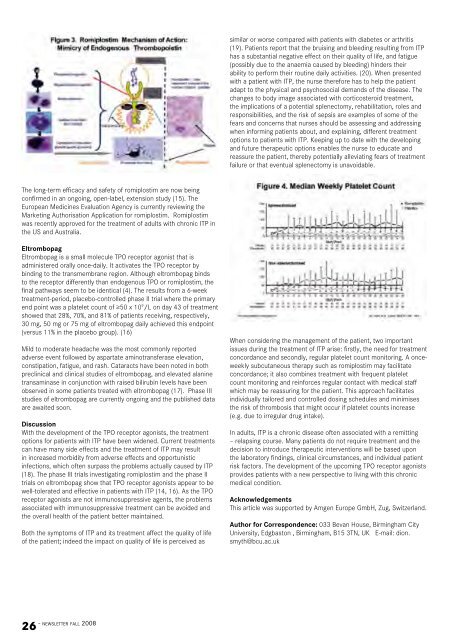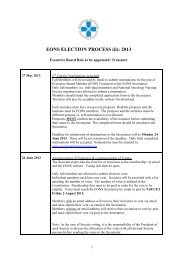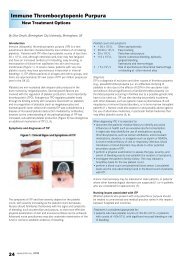English - the European Oncology Nursing Society
English - the European Oncology Nursing Society
English - the European Oncology Nursing Society
- No tags were found...
You also want an ePaper? Increase the reach of your titles
YUMPU automatically turns print PDFs into web optimized ePapers that Google loves.
similar or worse compared with patients with diabetes or arthritis(19). Patients report that <strong>the</strong> bruising and bleeding resulting from ITPhas a substantial negative effect on <strong>the</strong>ir quality of life, and fatigue(possibly due to <strong>the</strong> anaemia caused by bleeding) hinders <strong>the</strong>irability to perform <strong>the</strong>ir routine daily activities. (20). When presentedwith a patient with ITP, <strong>the</strong> nurse <strong>the</strong>refore has to help <strong>the</strong> patientadapt to <strong>the</strong> physical and psychosocial demands of <strong>the</strong> disease. Thechanges to body image associated with corticosteroid treatment,<strong>the</strong> implications of a potential splenectomy, rehabilitation, roles andresponsibilities, and <strong>the</strong> risk of sepsis are examples of some of <strong>the</strong>fears and concerns that nurses should be assessing and addressingwhen informing patients about, and explaining, different treatmentoptions to patients with ITP. Keeping up to date with <strong>the</strong> developingand future <strong>the</strong>rapeutic options enables <strong>the</strong> nurse to educate andreassure <strong>the</strong> patient, <strong>the</strong>reby potentially alleviating fears of treatmentfailure or that eventual splenectomy is unavoidable.The long-term efficacy and safety of romiplostim are now beingconfirmed in an ongoing, open-label, extension study (15). The<strong>European</strong> Medicines Evaluation Agency is currently reviewing <strong>the</strong>Marketing Authorisation Application for romiplostim. Romiplostimwas recently approved for <strong>the</strong> treatment of adults with chronic ITP in<strong>the</strong> US and Australia.EltrombopagEltrombopag is a small molecule TPO receptor agonist that isadministered orally once-daily. It activates <strong>the</strong> TPO receptor bybinding to <strong>the</strong> transmembrane region. Although eltrombopag bindsto <strong>the</strong> receptor differently than endogenous TPO or romiplostim, <strong>the</strong>final pathways seem to be identical (4). The results from a 6-weektreatment-period, placebo-controlled phase II trial where <strong>the</strong> primaryend point was a platelet count of ≥50 x 10 9 /L on day 43 of treatmentshowed that 28%, 70%, and 81% of patients receiving, respectively,30 mg, 50 mg or 75 mg of eltrombopag daily achieved this endpoint(versus 11% in <strong>the</strong> placebo group). (16)When considering <strong>the</strong> management of <strong>the</strong> patient, two importantMild to moderate headache was <strong>the</strong> most commonly reported issues during <strong>the</strong> treatment of ITP arise: firstly, <strong>the</strong> need for treatmentadverse event followed by aspartate aminotransferase elevation, concordance and secondly, regular platelet count monitoring. A onceweeklysubcutaneous <strong>the</strong>rapy such as romiplostim may facilitateconstipation, fatigue, and rash. Cataracts have been noted in bothpreclinical and clinical studies of eltrombopag, and elevated alanine concordance; it also combines treatment with frequent platelettransaminase in conjunction with raised bilirubin levels have been count monitoring and reinforces regular contact with medical staffobserved in some patients treated with eltrombopag (17). Phase III which may be reassuring for <strong>the</strong> patient. This approach facilitatesstudies of eltrombopag are currently ongoing and <strong>the</strong> published data individually tailored and controlled dosing schedules and minimisesare awaited soon.<strong>the</strong> risk of thrombosis that might occur if platelet counts increase(e.g. due to irregular drug intake).DiscussionWith <strong>the</strong> development of <strong>the</strong> TPO receptor agonists, <strong>the</strong> treatment In adults, ITP is a chronic disease often associated with a remittingoptions for patients with ITP have been widened. Current treatments – relapsing course. Many patients do not require treatment and <strong>the</strong>can have many side effects and <strong>the</strong> treatment of ITP may result decision to introduce <strong>the</strong>rapeutic interventions will be based uponin increased morbidity from adverse effects and opportunistic <strong>the</strong> laboratory findings, clinical circumstances, and individual patientinfections, which often surpass <strong>the</strong> problems actually caused by ITP risk factors. The development of <strong>the</strong> upcoming TPO receptor agonists(18). The phase III trials investigating romiplostim and <strong>the</strong> phase II provides patients with a new perspective to living with this chronictrials on eltrombopag show that TPO receptor agonists appear to be medical condition.well-tolerated and effective in patients with ITP (14, 16). As <strong>the</strong> TPOreceptor agonists are not immunosuppressive agents, <strong>the</strong> problems Acknowledgementsassociated with immunosuppressive treatment can be avoided and This article was supported by Amgen Europe GmbH, Zug, Switzerland.<strong>the</strong> overall health of <strong>the</strong> patient better maintained.Author for Correspondence: 033 Bevan House, Birmingham CityBoth <strong>the</strong> symptoms of ITP and its treatment affect <strong>the</strong> quality of life University, Edgbaston , Birmingham, B15 3TN, UK E-mail: dion.of <strong>the</strong> patient; indeed <strong>the</strong> impact on quality of life is perceived as smyth@bcu.ac.uk26 - newsletter fall 2008
















